by Todd Cox, Chief Technology Officer and Lead IT Architect
Click below to download the Cyber Security Risks Infographic.

by Todd Cox, Chief Technology Officer and Lead IT Architect
Click below to download the Cyber Security Risks Infographic.

Topics: Security, Infrastructure, Cloud Computing and Hosting
by Todd Cox, Chief Technology Officer and Lead IT Architect
Cloud Storage: Making the choice between Public Cloud and Private Cloud services.
Cloud Storage has increased in popularity with services like Dropbox and Google Drive. These products have made it simple to synchronize files between your phone, desktop, laptop, and tablet. The companies that offer this service have sophisticated redundant data centers where downtime becomes almost nonexistent, providing the ability to get your files anywhere, anytime, from any device.
While this may sound very attractive, there are some drawbacks. One obvious downside is the need for a reliable high-speed Internet connection in order to access your files, assuming they are not being stored locally in addition to the cloud. For this reason, cloud does not compete well with a local file share where access speed and time to open a file are critical. Even opening a simple Word document can be frustrating when downloading from the cloud when you are used to a local file share.
Certain use cases are certainly more suited towards cloud computing. Many companies are using cloud storage as their preferred backup storage, since it is offsite. Should anything happen to the primary location; users are able to switch over to the cloud location, providing a fantastic option to prevent downtime or data loss.
Another common complaint with cloud computing is that companies are unaware of where their data is physically being stored; this is done by the hosting company to provide extra security. However some companies have restrictions on whether sensitive data can leave the country or even their own premises. Of course, just because data is in the cloud with a reputable hosting provider does not mean there will never be a security breach. With the media making some of these security breaches very visible (think Amazon), many companies are not willing to take the risk.
With all of this considered, Able-One Systems typically recommends that a business use secure private storage but take advantage of cloud technology such as ownCloud or similar. This product offers all of the benefits of cloud computing while allowing the business the ability to control security and know where their data is being kept.
P.S. If you would like to understand more about cyber security risk and the cloud, sign up to attend one of our upcoming Cyber Risk Management events in the Toronto area. Click here for details.
Topics: Security, Infrastructure, Cloud Computing and Hosting
by Todd Cox, Chief Technology Officer and Lead IT Architect
To say that cyber crime is no small issue would be an understatement. According to the 2013 Norton Report, the cost of cyber crime hit Canadians to the tune of $3 billion in 2012 - which was double the year before. While that is only a small percentage of the $113 billion global number, it clearly highlights the pervasiveness of this issue. If you don’t think it will affect you, think again - the numbers show that 42% of adults experienced cyber crime last year alone.
By the end of 2013 it is expected that there will be 1.4 billion smart phones in use world wide. To put this in perspective, that is one smart phone for every five people! In a recent survey, 50% of smart phone users sleep within arm’s reach of their phone, showing that smart phones have truly become an extension of everyday life. What is particularly alarming is that 60% of Canadian users are not aware that security solutions even exist for their mobile devices.
It’s not just phones that pose hazards, social media sites have become a favourite for cyber crime, with almost half of users not signing out after using these sites. Not to mention passwords that are weak & easily guessed, rarely updated, and the same on multiple sites. This means if there is a breach on any site, like the one Adobe recently had (http://helpx.adobe.com/x-productkb/policy-pricing/customer-alert.html?promoid=KHQGF) many of an individual's accounts could be in danger – if the same password is used on multiple personal logins, what about on their business accounts? What happens when they are connected to the corporate network when they access these sites? The weakest link in any cyber security risk posture are the individual users.
What does this mean for business? For a start, it is important to understand that the impact and cost of cyber crime is not just a technology discussion, but truly a whole-business conversation:
What is our current risk & how exposed are we?
What policies and procedures do we need to put in place to deal with security, BYOD and business continuity?
How well does our current technology protect our corporate assets, maximize our organizational up-time and comply with industry regulations? How can we keep up with rapidly changing security risks with the budget we have?
Technology is a key component to prevent cybercrime but what happens when there is a breach? Whose liability is it? What provisions should we include in our contracts with service providers?
What about our residual risk – do we need insurance and how much?
Sources :
http://www.symantec.com/content/en/us/about/presskits/b-norton-report-2013.en_ca.pdf
http://www.businessinsider.com/15-billion-smartphones-in-the-world-22013-2
Topics: Security, Infrastructure
by Todd Cox, Chief Technology Officer and Lead IT Architect
Recently, I've been getting a lot of questions on IBM's new announcement regarding the Storwize V3700... essentially the little brother to the Storwize V7000. While at first glance, the products seem very similar in terms of functionality, there are several important issues to consider when evaluating the two solutions:
External Virtualization
While the V3700 has the concept of internal virtualization and disk pools like it's older brother, there is no external virtualization capability with the V3700. This means that I cannot front end older fibre channel based disk subsystems like I can with the V7000. This functionality really sets the V7000 apart from the competition, allowing my customers to extend the useful life of their aging storage assets already on the floor. Even if you don't buy into virtualizing older storage subsystems, this capability greatly aids in the migration of data through built in migration wizards.
Unified Option
One of the best features of the V7000 is the unified option which combines block and file-based subsystems into one full-function solution. With the V7000 unified comes Active Cloud Engine; functionality that allows me to tier my files across multiple media types based on straightforwardpolicies. ACE allows me to reduce the

cost of my overall storage footprint by storing files on the right type of media based on file type or usage pattern. The V3700 does not have a unified option and is block-based storage only. So no Active Cloud Engine either.
Scalability
Overall growth and scalability is limited on the V3700 as compared with it's older sibling. I can scale out up to 4 controllers on the V7000, with a total of 960 disk bays. On the V3700 I only have 120 drive bays before I max out.
Don't get me wrong; the V3700 is an amazing entry level addition to the Storwize family from IBM with functionality like thin provision and remote mirroring; functionality typically reserved for enterprise-class storage. That said, it is important to understand the main differences between the two offerings before heading down a particular solution path.
Learn more about the right Storage solution for your Environment at our seminar on January 29th at 11am.
Topics: Infrastructure
127 Victoria Street South
Kitchener, ON N2G 2B4 Canada
Email: info@ableone.com
Toll Free: (800) 461-2253
© 2017 Able-One. All Rights Reserved.